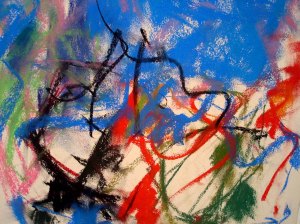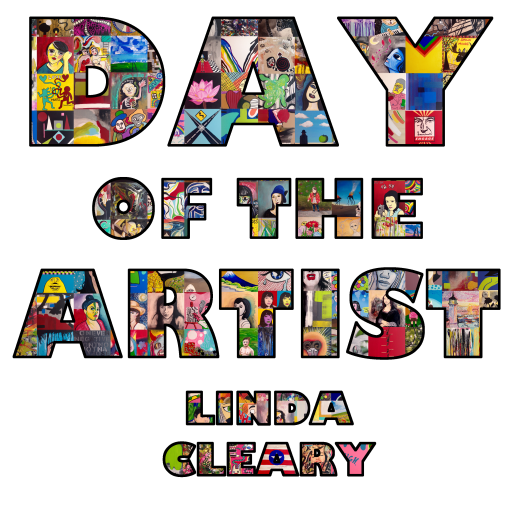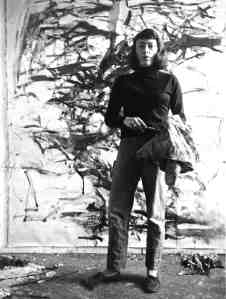Day 65! It’s been another crazy week, but I had a good time painting today. My painting didn’t turn out exactly the way I wanted it to or exactly how I pictured it in my mind, but I think it turned out okay. Been feeling under the weather and extremely anxious and weird, but I think it has to do with the big move and still have so much to do. Lots of repairs going on with the house and the roofing hasn’t even started. Yikes. Join me in celebrating Joan Mitchell today!

Joan Mitchell (February 12, 1925 – October 30, 1992) was a “second generation” abstract expressionist painter and printmaker. She was an essential member of the American Abstract expressionist movement, even though much of her career took place in France. Along with Lee Krasner, Grace Hartigan, and Helen Frankenthaler, she was one of her era’s few female painters to gain critical and public acclaim. Her paintings and editioned prints can be seen in major museums and collections across the United States and Europe.
Mitchell was born in Chicago, Illinois, the daughter of dermatologist James

Herbert Mitchell and poet Marion Strobel Mitchell. She lived on Chestnut Street in the Streeterville neighborhood and went to high school at Francis W. Parker School in the Lincoln Park neighborhood. She studied at Smith College in Massachusetts and The Art Institute of Chicago, where she earned her BFA in 1947 and her MFA in 1950. After moving to Manhattan in 1947, she wanted to study at Hans Hofmann’s school in New York but, according to Jane Livingston in her 2002 essay (“The Paintings of Joan Mitchell”), Mitchell attended only one class and declared, “I couldn’t understand a word he said so I left, terrified.” A $2,000 travel fellowship allowed her to study in Paris and Provence in 1948-49, and she also traveled in Spain and Italy.

Mitchell married American publisher Barney Rosset in 1949 in Paris. Rosset was a Chicago-born American entrepreneur and former owner of the publishing house Grove Press, who is perhaps best known as the American publisher of the controversial and sexually charged novel Tropic of Cancer by Henry Miller. They divorced in 1952. Although she remained active in the burgeoning art scene of 1950s New York, Mitchell spent increasing amounts of time travelling and working in France. In 1955, Mitchell moved to France to join Canadian painter Jean-Paul Riopelle, with whom she had a long, rich, and tumultuous relationship (from 1955 to 1979). They maintained separate homes and studios, but had dinner and drank together daily. They first lived in Paris, and then moved west to the town of Vétheuil, near Giverny, Claude Monet’s home. In 1967, Mitchell inherited enough money to purchase a 2-acre estate in Vétheuil.
In October 1957, the first major feature on her work method appeared in

ARTnews.
Mitchell is recognized as a principal figure – and one of the few female artists – in the second generation of American Abstract Expressionists. By the early 1950s, she was regarded as a leading artist in the New York School. In her early years as a painter, she was influenced by Vincent van Gogh, Paul Cézanne, Wassily Kandinsky, and later by the work of Franz Kline andWillem de Kooning, among others.

Her paintings are expansive, often covering two separate panels. Landscape was the primary influence on her subject matter. She painted on unprimed canvas or white ground with gestural, sometimes violent brushwork. She has described a painting as, “an organism that turns in space”.
An admirer of Vincent van Gogh’s work, Mitchell observed in one of his final paintings – Wheatfield with Crows (1890) – the symbology of death, suicide, hopelessness, depression and darkness. With her sense that Wheatfield with Crows was a suicide note, she painted a painting called No Birds as a response and as an homage.
After moving to Paris in 1959, Mitchell began painting in a studio on the rue Fremicourt.

During the period between 1960 and 1964, she moved away from the all-over style and bright colors of her earlier compositions, instead using sombre hues and dense central masses of color to express something inchoate and primordial. The marks on these works were said to be extraordinary: “The paint flung and squeezed on to the canvases, spilling and spluttering across their surfaces and smeared on with the artist’s fingers.”
Mitchell said that she wanted her paintings “to convey the feeling of the dying sunflower” and “some of them come out like young girls, very coy … they’re very human.”

From the early 1980s, when Mitchell’s health began to fail, until 1992, when she died, her work changed significantly. In 1984, she was diagnosed with advanced oral cancer and a mandibulectomy (removal of the jaw) was advised. In October, she obtained a second opinion from Jean-Pierre Bataini, a pioneer in radiation oncology with the Curie Institute, whose therapy was successful, but left Mitchell with a dead jawbone (osteonecrosis), along with anxiety and depression. She had quit smoking on doctor’s orders, but remained a heavy drinker.
Mitchell commenced sessions with Parisian psychoanalyst Christiane Rousseaux-Mosettig in November 1984. Mitchell’s post-cancer paintings reflect the psychological changes cancer had effected: six Between paintings, Faded Air I, Faded Air II, the A Few Days cycle, the Before, Again cycle and the Then, Last Time group of four. Also, in the final years of her life Mitchell returned to the subject of sunflowers with renewed focus. As in Sunflowers, 1990–91, she chose to paint the flowers in a state of decay, reinforcing her desire for the work to “convey the feeling of a dying sunflower.”
Mitchell developed osteoarthritis as a result of hip dysplasia. She underwent hip replacement surgery at Hôpital Cochin in

December 1985, but with little success. During her subsequent recuperation at a clinic in Louveciennes, she started watercolor painting. Her postoperative difficulties necessitated using an easel and working on a smaller format. Her River cycle is emblematic of this period.
Mitchell’s New York dealer, Xavier Fourcade, had been diagnosed with AIDS and, in 1986, travelled to France to undergo treatment. Fourcade and Mitchell visited Lille in December to view an exhibition of works by Henri Matisse from the State Hermitage Museum, Leningrad. The trip resulted in the Lille cycle of paintings, followed, after Xavier Fourcade’s death on April 28, 1987, by the Chord paintings. The River, Lille and Cord paintings were exhibited at Galerie Jean Fournier, Paris between June 10 and July 13, 1987.
In October 1992, Mitchell flew to New York for the Matisse exhibition at the Museum of Modern Art. Upon her arrival, she was taken to a doctor, who diagnosed advanced lung cancer. She returned to Paris on October 22, returning to Vétheuil briefly before entering hospital in Paris, where friends like John Cheim and Joseph Strick visited her.
Joan Mitchell died on the morning of October 30, 1992 at the American Hospital of Paris.
On the eve of Mitchell’s full-scale retrospective at the Whitney Museum of American Art, friend and art writer Klaus Kertess wrote in the New York Times:
A passionate inner vision guided Joan’s brush. Like her peer Cy Twombly, she extended the vocabulary of her Abstract Expressionist forebears. She imbued their painterliness with a compositional and chromatic bravery that defiantly alarms us into grasping their beauty.
Biography is from wikipedia.

I definitely wanted to do a cityscape painting for my Joan Mitchell tribute. So I went online and looked at various cityscapes. I chose one that I found that I couldn’t resist attempting to do an abstract version of. It was very difficult, much harder than I expected. I had this vision of what I wanted it to look like…I don’t think I achieved it fully, but I think it turned out okay.
I hope you enjoy my piece in honor of Joan Mitchell! And I will see you tomorrow on Day 66! Only 300 more paintings to go. Whew.
Best, Linda

Linda Cleary 2014
Acrylic on Canvas

City at Night- Tribute to Joan Mitchell
Linda Cleary 2014
Acrylic on Canvas

City at Night- Tribute to Joan Mitchell
Linda Cleary 2014
Acrylic on Canvas

City at Night- Tribute to Joan Mitchell
Linda Cleary 2014
Acrylic on Canvas

City at Night- Tribute to Joan Mitchell
Linda Cleary 2014
Acrylic on Canvas


really like the textural feel of this tribute.